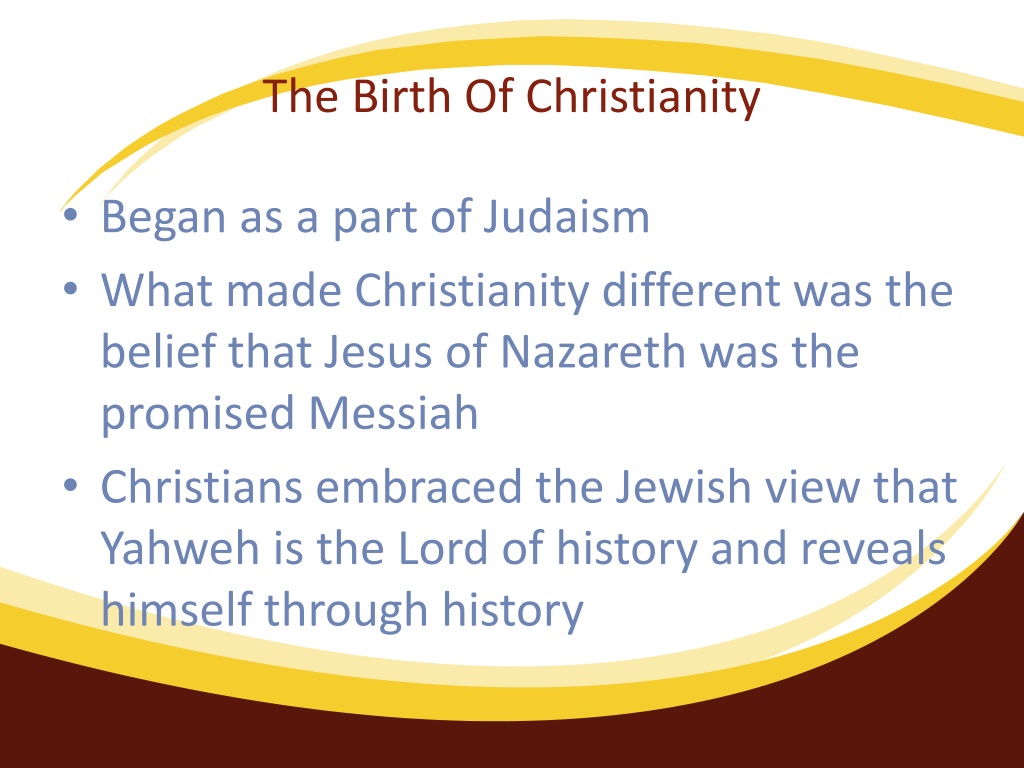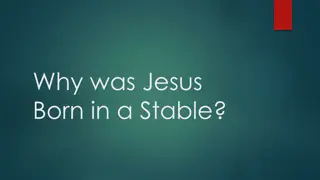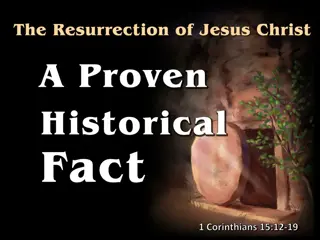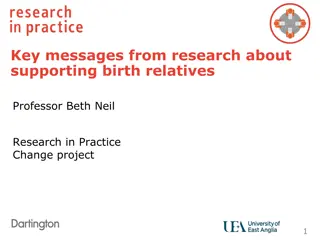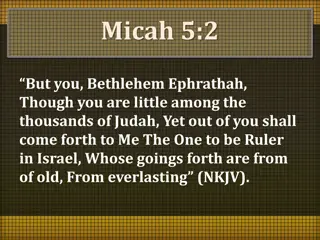The Birth and Life of Christianity: The Story of Jesus
The birth of Christianity emerged from Judaism, with a key distinction being the belief in Jesus of Nazareth as the promised Messiah. Christianity centers around the life and teachings of Jesus, fulfilling prophetic promises and initiating a new covenant. The New Testament presents Jesus as the focal point of history, revealing God's plan for humanity. The Gospels provide primary insights into Jesus' life and significance, while historical accounts shed additional light. Jesus' ministry, teachings, and ultimate sacrifice mark a significant shift in religious narratives, impacting both Jewish and Roman contexts.
Download Presentation

Please find below an Image/Link to download the presentation.
The content on the website is provided AS IS for your information and personal use only. It may not be sold, licensed, or shared on other websites without obtaining consent from the author. Download presentation by click this link. If you encounter any issues during the download, it is possible that the publisher has removed the file from their server.
E N D
Presentation Transcript
The Birth Of Christianity Began as a part of Judaism What made Christianity different was the belief that Jesus of Nazareth was the promised Messiah Christians embraced the Jewish view that Yahweh is the Lord of history and reveals himself through history
The Birth Of Christianity For Judaism, the center of history remained in the events surrounding Moses For Christianity, Jesus and the events surrounding him became the center.
The Birth Of Christianity The New Testament begins the story of the New Covenant mentioned in Jeremiah 31. The NT does not tell a new story; it reveals God s conclusion to the story he has been telling since the beginning. God sent Jesus in fulfillment of prophetic promise to provide a way for people to live in a relationship with Him.
The Life of Jesus 1. The New Testament Gospels are our primary source of information about Jesus. Other ancient historians such as Josephus, Suetonius, Tacitus, as well as the Jewish Talmud, also mention Jesus and the early Christians, but they add little to what we find in the New Testament.
The Life of Jesus The Gospels tell us what early Christians believed about Jesus, both the person of Jesus and his significance. Some scholars have a problem separating what the community believed about Jesus and Jesus as a person.
The Jesus of history 1. He was born between 7 and 3 B.C.E, in Bethlehem. 2. He grew up as a Jew in Nazareth. 3. He began his formal ministry in conjunction with his baptism by John the Baptist. 4. He gathered disciples.
The Jesus of history 5. There was an apocalyptic dimension to his ministry, illustrated by the abundance of references to the kingdom of God in his parables. His teaching placed him in conflict with established Judaism, especially with the Pharisees He died on a cross at the hands of the Romans. 6. 7.
The Jesus of history 8. There was a messianic dimension to his ministry. 9. The Gospel writers would add to this list the resurrection of Jesus from the dead. The resurrection is clearly reported in the Gospels as a historic fact. This was what convinced early believers that Jesus was the Messiah.
The Life of Jesus Matthew begins his Gospel by tracing the ancestry of Jesus back to the mighty king of Israel, David, and the founder of the nation, Abraham. Luke, looking beyond Israel to the whole of world history, traces Jesus back to the very first human being, Adam, who was the direct creation of God.
The Life of Jesus It is John who catches the ultimate significance of Jesus by tracing Him back beyond recorded time to the very depths of God himself, from whom He came as the word of God, the bearer of life and light for all human kind.
An Outline of Jesus Life Jesus Birth and Youth The Beginning of Jesus Public Ministry The Galilean Ministry Jesus Travels Outside of Galilee The Perean and Judean Ministry 6 B. C. - A.D. 26 A.D. 26-27 A.D. 27-29 A.D. 29 A.D. 29-30
An Outline of Jesus Life Jesus Last Week and Crucifixion The Resurrection and Ascension of Jesus A.D. 30 (April) A.D. 30 (June)
Life and Teaching Jesus came at the exact time God had decided (Gal. 4:4; Eph. 1:10) Gal. 4:4 But when the fulness of time was come, God sent forth His Son, made of a woman, made under the law. KJV Eph. 1:10 as a plan for the fulness of time, to unite all things in him (Jesus), things in heaven and things on earth.
Life and Teaching It was a time uniquely suited for the spread of the gospel: Universal language: Greek Philosophers shared new ideas Pax Romana Roman roads
Life and Teaching Jesus presented himself as the fulfillment of Old Testament prophecy, the Messiah who was to come and the Savior of the world. Jesus showed his power through healing diseases, exercising control over nature, raising the dead, and triumphing over the force of Satan and demons.
Jewish Leaders Opposed Jesus 1. They were jealous of him. 2. They were jealous of His authority. 3. The perceived Him as dangerous. 4. They feared his liberal attitudes. 5. They hated his social attitudes. 6. They scoffed at his lack of formal education. 7. They feared His power.
Jewish Leaders Opposed Jesus 8. Because of their political fears. 9. Because of His call for repentance. 10.Because of His knowledge. 11.Because of His popularity.
Jesus has meaning and significance for Christians because: A. Of his uniqueness. B. His story is supernatural from beginning to end. C. There is the challenge of Jesus for people to believe, and his command to follow Him.
Meaning and Significance D. The story of Jesus tells us that death is not the end of anything, but for Christ s followers, the beginning of a glorious new existence. E. Jesus is alive and promises to be with his followers now and to the end of the age.
Jesus, the Teacher 1. Jesus was a creative teacher, using parables, illustrations, object lessons, and proverbial sayings. 2. To understand the teaching of Jesus we must remember that Jesus delivered his messages in spoken fashion; he shared fundamental assumptions with his audience; . . .
Jesus, the Teacher . . . He needed to find an effective way to communicate his message; and he had the goal of challenging people to make a decision to enter the Kingdom.
Four Theological Themes 1) 2) God, the Kingdom of God, Jesus relation to the Kingdom. The uniqueness of Jesus; his special relation to God; his special relation to other human beings. Human life; human sinfulness, and God. The end of the age; the second coming; and the life to come. 3) 4)
